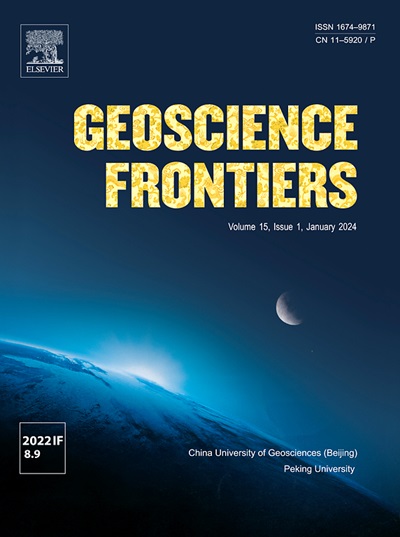Ore geology, mineralogy and geochemistry of a fault-controlled hydrothermal clay-Li deposit hosted by Precambrian metasedimentary rocks in south China
IF 8.5
1区 地球科学
Q1 GEOSCIENCES, MULTIDISCIPLINARY
引用次数: 0
Abstract
The Jinyinshan-Huangdi′nao Li deposit (12,000 t Li2O @ 0.60%) was recently discovered in southern Hubei Province, South China. This deposit is divided into two ore sections, namely, Jinyinshan (0.24–1.32 wt.% Li2O) and Huangdi′nao (0.20–0.47 wt.% Li2O). The dominant Li-bearing phase and mechanism for Li enrichment remain unclear. Herein, a comprehensive study of ore geology, mineralogy and geochemistry is conducted. Field and petrographic investigations revealed that Li mineralization in the deposit was fault-controlled and that the altered metasedimentary rocks and hydrothermal veins with intensive Li mineralization contained high abundances of Li-rich clay minerals. Whole-rock XRD and in situ analyses of SEM-EDS, EMPA and LA-ICP-MS of clay minerals reveal that cookeite (0.99–2.80 wt.% Li2O) is the dominant Li-bearing phase, with subordinate illite (0.02–0.57 wt.% Li2O). The widespread replacement of Li-enriched illite by cookeite combined with the compositional continuum suggests that cookeite was likely formed by the hydrothermal replacement of illite at a temperature of 240–270 °C, as constrained by chlorite geothermometry (with average temperatures of 254 ± 2 °C in Jinyinshan and 259 ± 2 °C in Huangdi′nao). Since metasedimentary rocks of the Neoproterozoic Lengjiaxi Group in the deposit with variable Li anomalies host abundant Li-rich illite, Li mineralization was inferred to have occurred via hydrothermal metasomatism of these clay-rich clastic rocks. The hydrothermal fluids may have been driven by a deep magmatic heat source, as evidenced by previously reported U-Pb dating of apatite from the clay-Li ore, similar to the age of the Mufushan granitic batholith in the south, both of which are Early Cretaceous. The deep-sourced hydrothermal fluids caused the mobilization, migration and reprecipitation of Li as Li-rich clays along the fault zones. This mechanism of Li mineralization is different from existing models for clay-Li deposits worldwide, and this deposit can be classified as a new type, namely, fault-controlled hydrothermal metasomatic clay-Li deposit. Similar deposits are highly prospective both regionally and worldwide.

华南前寒武纪变质沉积岩型断控热液粘土-锂矿床的矿石地质、矿物学和地球化学
湖北南部金银山—黄帝脑里矿床(Li2O @ 0.60%,品位1.2万t)是近期发现的。该矿床分为金银山矿段(Li2O含量0.24 ~ 1.32 wt.%)和黄帝脑矿段(Li2O含量0.20 ~ 0.47 wt.%)。主要含锂相及富集机制尚不清楚。在此基础上,对矿石进行了地质、矿物学和地球化学的综合研究。野外和岩石学研究表明,矿床内的锂成矿作用受断裂控制,蚀变变质沉积岩和热液脉中含高丰度的富锂粘土矿物。黏土矿物的全岩XRD、SEM-EDS、EMPA、LA-ICP-MS等原位分析结果表明,含锂相以cookeite (0.99 ~ 2.80 wt.% Li2O)为主,伊利石(0.02 ~ 0.57 wt.% Li2O)次之。富锂伊利石被库克石广泛替代,结合组成连续统,表明库克石可能是在240 ~ 270℃的温度下由伊利石热液替代而形成的,受绿泥石地热测量(金银山平均温度254±2℃,黄帝脑平均温度259±2℃)的限制。由于变锂异常矿床中新元古代冷家溪群变质沉积岩中含有丰富的富锂伊利石,推测其成矿作用是通过富泥碎屑岩热液交代作用发生的。热液流体可能是由深部岩浆热源驱动的,之前报道的粘土- li矿石磷灰石U-Pb测年证明了这一点,与南部木浮山花岗岩基的年龄相似,都是早白垩世。深源热液使Li沿断裂带以富Li粘土的形式被动员、迁移和再沉淀。该矿床成矿机制不同于国际上已有的粘土-锂矿床模式,可归类为断裂控制热液交代型粘土-锂矿床。类似的矿床在区域和世界范围内都具有很高的前景。
本文章由计算机程序翻译,如有差异,请以英文原文为准。
求助全文
约1分钟内获得全文
求助全文
来源期刊

Geoscience frontiers
Earth and Planetary Sciences-General Earth and Planetary Sciences
CiteScore
17.80
自引率
3.40%
发文量
147
审稿时长
35 days
期刊介绍:
Geoscience Frontiers (GSF) is the Journal of China University of Geosciences (Beijing) and Peking University. It publishes peer-reviewed research articles and reviews in interdisciplinary fields of Earth and Planetary Sciences. GSF covers various research areas including petrology and geochemistry, lithospheric architecture and mantle dynamics, global tectonics, economic geology and fuel exploration, geophysics, stratigraphy and paleontology, environmental and engineering geology, astrogeology, and the nexus of resources-energy-emissions-climate under Sustainable Development Goals. The journal aims to bridge innovative, provocative, and challenging concepts and models in these fields, providing insights on correlations and evolution.
 求助内容:
求助内容: 应助结果提醒方式:
应助结果提醒方式:


